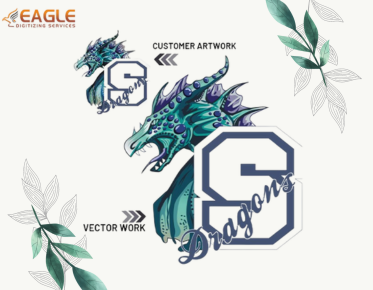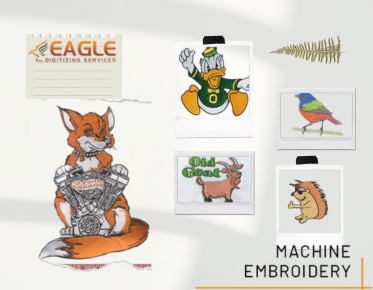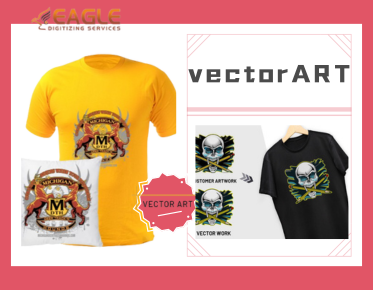The Importance of Vector Format Logos for Illuminated Signage: Maximizing Brand Visibility and Impact
In the realm of branding and marketing, illuminated signage stands out as a powerful tool for attracting attention and reinforcing brand identity. Central to the effectiveness of illuminated signs is the logo, serving as a visual representation of the brand. Understanding the importance of vector format logos in illuminated signage is crucial for maximizing brand visibility and impact.
Understanding
Illuminated Signage
Importance of Signage in Branding
and Marketing
Signage plays a pivotal role in branding and marketing strategies,
serving as a direct communication channel with customers. Well-designed signage
not only attracts attention but also reinforces brand identity, enhances brand
recognition and drives foot traffic to businesses.
Types of Illuminated Signage:
LED, Neon, and Backlit Signs
Illuminated signage comes in various forms, including LED, neon, and
backlit signs. Each type offers unique visual effects and advantages, depending
on the desired aesthetic and practical considerations such as energy efficiency
and maintenance requirements.
Significance of Logo in Signage
Design
The logo is the cornerstone of any brand's visual identity and plays a central role in signage design. It serves as a memorable symbol that instantly communicates brand values, personality, and offerings to customers. Incorporating the logo effectively into illuminated signage is essential for creating impactful and cohesive brand experiences.
The
Role of Logos in Illuminated Signage
Logo as Brand Identity:
Recognizability and Memorability
The logo serves as the face of the brand, representing its identity
and values. In illuminated signage, a well-designed logo enhances brand
recognizability and memorability, making a lasting impression on viewers and
reinforcing brand recall.
Impact of Logo Design on Signage
Effectiveness
The design of the logo directly influences the effectiveness of
illuminated signage. A visually striking and well-executed logo attracts
attention, communicates brand messaging clearly, and enhances the overall
aesthetic appeal of the signage.
Challenges of Reproducing Logos
in Illuminated Signage
Reproducing logos in illuminated signage poses unique challenges, including maintaining clarity, color accuracy, and scalability. Vector format logos offer solutions to these challenges by providing flexibility, precision, and scalability without loss of quality.
Vector
vs. Raster: A Brief Comparison
Characteristics of Vector
Graphics
Vector graphics are based on mathematical equations, defining shapes
using points, lines, and curves. They are resolution-independent, allowing for
infinite scalability without loss of quality. Vector formats include EPS
(Encapsulated PostScript), AI (Adobe Illustrator), and SVG (Scalable Vector
Graphics).
Characteristics of Raster
Graphics
Raster graphics consist of pixels arranged in a grid, representing
images through color and intensity values. They are resolution-dependent,
meaning that scaling beyond their original size can result in pixelation and
loss of detail. Common raster formats include JPEG, PNG, and TIFF.
Importance of Format Choice for
Signage
Choosing the right format for logos in illuminated signage is critical for achieving optimal results. Vector format logos offer advantages in scalability, clarity, and compatibility with signage software, making them the preferred choice for high-quality and effective signage.
Advantages
of Vector Format for Illuminated Signage
Scalability: Maintaining Quality
at Any Size
Vector format logos can be scaled to any size without loss of quality,
ensuring crisp and clear reproduction in illuminated signage, regardless of
dimensions. This scalability makes them ideal for large-format displays and
ensures consistent branding across various applications.
Clarity and Precision: Crisp
Lines and Shapes
Vector graphics provide unparalleled clarity and precision, with crisp
lines and defined shapes that enhance the visual impact of illuminated signage.
The mathematical precision of vector format logos ensures that intricate
details are faithfully reproduced, even in the most challenging lighting
conditions.
Compatibility: Seamless
Integration with Signage Software
Vector format logos seamlessly integrate with signage software, allowing for easy customization, editing, and manipulation. This compatibility streamlines the signage production process, enabling designers to achieve precise and consistent results with minimal effort.
Challenges
of Using Raster Format for Illuminated Signage
Loss of Quality: Pixelation
Issues
Raster format logos are susceptible to loss of quality when scaled up
for illuminated signage, leading to pixelation and blurriness. This loss of
detail detracts from the visual impact of the signage and compromises brand
identity and professionalism.
Limited Scalability: Size
Restrictions
Raster graphics have inherent limitations in scalability, making them
unsuitable for large-format illuminated signage. Designers must carefully
consider the size and resolution of raster format logos to avoid degradation in
quality and visual appeal.
File Size Concerns: Impact on
Signage Production
Raster format logos tend to have larger file sizes compared to their vector counterparts, resulting in increased storage requirements and longer production times for illuminated signage. Managing these file size concerns is essential for optimizing workflow efficiency and maintaining project timelines.
Vector
Format Logo Design Best Practices
Simplification: Streamlining
Complex Designs
Simplifying logo designs is essential for optimal reproduction in
illuminated signage. Complex elements may not translate well in large-scale
formats, leading to visual clutter and reduced legibility. Streamlining the
design ensures clarity and impact, even from a distance.
Use of Basic Shapes: Ensuring
Clarity
Incorporating basic shapes and geometric forms in logo design enhances
clarity and readability in illuminated signage. Simple shapes are easily
recognizable and lend themselves well to scalability, making them effective
elements for creating memorable and impactful signage.
Consideration for Illumination
Effects: Compatibility with Signage Lighting
Designing vector format logos with consideration for illumination effects ensures compatibility with various lighting conditions used in illuminated signage. Optimal contrast, color balance, and shadowing enhance visibility and legibility, maximizing the effectiveness of the signage.
Technical
Considerations for Vector Format Logos
Choosing the Right Software:
Adobe Illustrator and Alternatives
Designing vector format logos requires specialized software such as
Adobe Illustrator, known for its comprehensive tools and capabilities.
Alternatives like CorelDRAW and Inkscape offer similar functionality, catering
to different preferences and budget constraints.
Exporting in Vector Formats:
EPS, AI, and SVG
Exporting logos in vector formats ensures compatibility with signage
software and production processes. Common vector formats include EPS
(Encapsulated PostScript), AI (Adobe Illustrator), and SVG (Scalable Vector
Graphics), each offering unique advantages in terms of compatibility and
scalability.
Working with Designers:
Communicating Format Requirements
Collaborating with designers is essential for creating vector format logos optimized for illuminated signage. Clear communication of format requirements, scalability needs, and illumination considerations ensures that the final design meets the project objectives and specifications.
Future
Trends in Illuminated Signage
Technological Advancements:
Innovations in Signage Display
Technological advancements drive innovations in illuminated signage
displays, offering new capabilities and visual effects. LED advancements,
interactive displays, and augmented reality integration represent emerging
trends that enhance the effectiveness and engagement of illuminated signage.
Interactive Signage: Engaging
Customers with Dynamic Logos
Interactive signage with dynamic logos creates immersive brand
experiences that engage customers and drive interaction. Touchscreen displays,
motion sensors, and personalized content delivery offer new opportunities for
brands to connect with their audience and leave a lasting impression.
Sustainability: Eco-friendly
Signage Solutions
Sustainability considerations influence the design and implementation of illuminated signage, leading to the adoption of eco-friendly materials and energy-efficient lighting solutions. Solar-powered signage, recyclable materials, and low-energy LED technologies represent sustainable trends in signage design and production.
Tips
for Selecting an Illuminated Signage Provider
Experience and Expertise in Vector
Logo Integration
Choosing an illuminated signage provider with experience and expertise
in vector artwork logo integration is essential for achieving
optimal results. Knowledge of vector graphics, signage software, and production
processes ensures seamless integration and high-quality output.
Quality of Materials and
Craftsmanship
The quality of materials and craftsmanship used in illuminated signage
directly impacts its durability, longevity, and visual appeal. Selecting a
provider that prioritizes quality ensures that signage not only looks
impressive but also withstands the test of time and environmental conditions.
Customer Service and Support
Effective customer service and support are critical factors in selecting an illuminated signage provider. Responsive communication, attentive project management, and post-installation support contribute to a positive experience and successful outcome for signage projects.
Ethical
Considerations in Signage Design
Respect for Intellectual
Property: Copyright and Trademarks
Respecting intellectual property rights, including copyrights and
trademarks, is paramount in signage design. Unauthorized use of logos or
designs can result in legal consequences and reputational damage. Obtaining
proper permissions and licenses ensures ethical and legal compliance in signage
projects.
Environmental Impact:
Sustainable Signage Practices
Minimizing the environmental impact of signage design and production
involves adopting sustainable practices and materials. From energy-efficient
lighting to recyclable materials and responsible waste management, prioritizing
sustainability ensures ethical and eco-friendly signage solutions.
Inclusivity: Accessibility in
Signage Design
Designing signage with inclusivity in mind ensures accessibility for all individuals, including those with disabilities. Considerations such as legible fonts, high-contrast colors, tactile elements, and braille signage contribute to inclusive design practices that accommodate diverse needs and promote equal access.
Vector format logos play a crucial role in the effectiveness and
impact of illuminated signage. Their scalability, clarity, and compatibility
make them the preferred choice for creating visually compelling and memorable
signage solutions that enhance brand visibility and engagement.
Understanding the benefits and considerations of vector format logos in illuminated signage is essential for making informed choices and achieving optimal results. Scalability, clarity, and compatibility considerations, along with best practices and case studies, provide valuable insights for signage projects.
By taking into account the role of vector format logos, technical considerations, future trends, and ethical considerations, businesses can make well-informed choices for effective illuminated signage solutions. And Eagle Digitizing, which provides vector conversion services, can play a crucial role here. Collaboration with experienced providers like Eagle Digitizing and adherence to best practices ensure successful outcomes that maximize brand visibility and impact.
Maximizing brand visibility and impact through
illuminated signage demands meticulous consideration of design, format, and
implementation. Vector format logos, with the assistance of services like Eagle
Digitizing, offer a potent means for creating visually captivating and
memorable signage that engages audiences, reinforces brand identity, and drives
business success.



